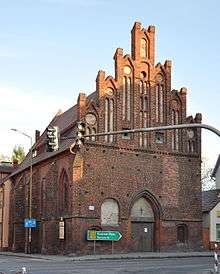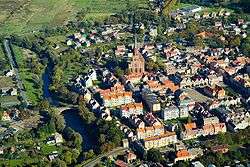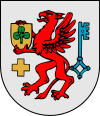Trzebiatów
| Trzebiatów | ||
|---|---|---|
|
Bird's-eye view on the Old Town | ||
| ||
 Trzebiatów | ||
| Coordinates: 54°3′26″N 15°16′43″E / 54.05722°N 15.27861°E | ||
| Country |
| |
| Voivodeship | West Pomeranian | |
| County | Gryfice | |
| Gmina | Trzebiatów | |
| Established | 9th century | |
| City rights | 1277 | |
| Government | ||
| • Mayor | Zdzisław Matusewicz | |
| Area | ||
| • Total | 10.14 km2 (3.92 sq mi) | |
| Population (2007) | ||
| • Total | 10,196 | |
| • Density | 1,000/km2 (2,600/sq mi) | |
| Time zone | CET (UTC+1) | |
| • Summer (DST) | CEST (UTC+2) | |
| Postal code | 72-320 | |
| Car plates | ZGY | |
| Website | http://www.trzebiatow.pl | |
Trzebiatów [tʂɛˈbjatuf] (German: Treptow an der Rega, German pronunciation: [ˈtʁeːptoː]) is a town in the West Pomeranian Voivodeship, Poland. As of June 2007, it has 10,196 inhabitants.
History
The lower Rega area around Gryfice and Trzebiatów was site of a Slavic gród in the 9th century. The first recorded mention of the town comes from 1170 when the Pomeranian duke Kasimir I granted a few villages and oversight of a church in the town to settlers from Lund in Sweden.

In 1504, Johannes Bugenhagen moved to the town and became Rector of the local school.[1] On December 13, 1534, a diet was assembled in the town, where the Dukes Barnim XI and Philip I as well as the nobility officially introduced Lutheranism to Pomerania, against the vote of Erasmus von Manteuffel, Prince-Bishop of Cammin. In the following month Bugenhagen drafted the new church order (Kirchenordnung), founding the Pomeranian Lutheran church, today's Pomeranian Evangelical Church.[2][3][4]
As a dowager, Sophia of Schleswig-Holstein-Sonderburg (1579–1658), widow of Philip II, Duke of Pomerania, lived in Treptow. Sophia's dower was a former nunnery, which she converted into a palace. While in Swedish service and thereafter Duke Francis Henry of Saxe-Lauenburg spent a lot of time with Duchess dowager Sophia in Treptow. Sophia's and Francis Henry's fathers were cousins. On 13 December 1637 Francis Henry and Marie Juliane of Nassau-Siegen (1612–1665) married in Treptow.[5] Their first child was born in Treptow in 1640.[6] Francis Henry also served Sophia as administrator of the estates pertaining to her dower.[6]
When in 1637 with Philip II's death the Pomeranian ducal house was extinct, the duchy was under Swedish occupation with the Brandenburgian electors claiming succession in Pomerania. Not until 1648 the electors prevailed in succeeding as dukes of Pomerania, however, only in the central and eastern part of ducal Pomerania (1653–1815), including Treptow.

In 1750 Treptow Palace was refurbished in classicist style for General Frederick Eugene of Württemberg, who resided there – with interruptions – until 1763. With the end of the Holy Roman Empire in 1806, Brandenburg-Pomerania, already since 1618 ruled in personal union with Ducal Prussia (Kingdom since 1701), also legally merged into Prussia and the different German confederacies and empires, of which it formed part since. In 1945 central and eastern Pomerania, including Treptow, became part of Poland.
Culture
Trzebiatów's Day of the Buckwheat is a celebration during the first week of August. It is a memorial to day when the town guard by mistake dropped a hot bowl of buckwheat meal on invaders from the nearby town of Gryfice, alarming whole town and saving it. Inhabitants of Trzebiatów celebrate that event with dances, concerts, competitions and eating of cereal with ham and bacon.
People
- Johannes Bugenhagen (1505–1521), Pomeranian reformer, rector at Treptow city school
- Johannes Aepinus, theologian and reformer
- Frederick I of Württemberg (1754–1816), King of Württemberg
- Louis of Württemberg (1756–1817), Duke of Württemberg
- Ferdinand Friedrich August of Württemberg (1763- ), Duke of Württemberg
- Johann Gustav Droysen (1808–1884), historian
- Ferdinand von Arnim (1814–1866), architect
- Peter Friedrich Arnd (1817–1866), mathematician
- Marcus Kalisch (1828–1885), Jewish scholar
Twinning cities
The sister cities of Trzebiatów are:
 Grevesmühlen, Germany
Grevesmühlen, Germany Istebna, Poland
Istebna, Poland Sjöbo, Sweden
Sjöbo, Sweden Wandlitz, Germany
Wandlitz, Germany
References
- ↑ Hamburgische Biografie: Personenlexikon: 5 vols. (so far), Franklin Kopitzsch and Dirk Brietzke (eds.), Hamburg: Christians, 2001–2003 (vols 1–2), Göttingen: Wallstein, 2006– (to be continued), vol. 2 (2003), p. 79. ISBN 3-7672-1366-4.
- ↑ Pommern (11999), revised, and updated ed., Werner Buchholz (ed.), Berlin: Siedler, 22002, (=Deutsche Geschichte im Osten Europas), pp. 205-220. ISBN 3-88680-780-0.
- ↑ Theologische Realenzyklopädie: 36 vols., Gerhard Müller, Horst Balz and Gerhard Krause (eds.), Berlin et al.: de Gruyter, 1977–2007, vol. 27 (1997): 'Politik, Politologie - Publizistik, Presse', pp. 43ff. ISBN 3-11-015435-8.
- ↑ Richard Du Moulin Eckart, Geschichte der deutschen Universitäten (11929), reprint: Hildesheim and New York: Olms, 21976, pp. 111f. ISBN 3-487-06078-7.
- ↑ N.N., "VII. Sophie von Schleswig-Holstein, Witwe Herzog Philipps II. von Pommern, auf dem Schlosse in Treptow an der Rega", in: Baltische Studien (1832 to date), vol. 1, Gesellschaft für Pommersche Geschichte und Alterthumskunde and Historische Kommission für Pommern (eds.), vol. 1: Stettin: Friedrich Heinrich Morin, 1832, pp. 247–259, here pp. 250 and 257.
- 1 2 N.N., "VII. Sophie von Schleswig-Holstein, Witwe Herzog Philipps II. von Pommern, auf dem Schlosse in Treptow an der Rega", in: Baltische Studien (1832 to date), vol. 1, Gesellschaft für Pommersche Geschichte und Alterthumskunde and Historische Kommission für Pommern (eds.), vol. 1: Stettin: Friedrich Heinrich Morin, 1832, pp. 247–259, here p. 257.
Coordinates: 54°03′45″N 15°15′56″E / 54.06250°N 15.26556°E
| Wikimedia Commons has media related to Trzebiatów. |
| ||||||||||||
| ||||||||||||||||||||||||||||||||||||||||||||||||||||||||
| ||||||||||||||||||||||||||||||||||||||||||||||||||||||||||||||||||||||||||||||||||||||||||||||||||
|

